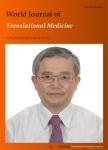p38 mitogen-activated protein kinase regulates type-Ⅰ vs type-Ⅱ phenotyping of human vascular endothelial cells
p38 mitogen-activated protein kinase regulates type-Ⅰ vs type-Ⅱ phenotyping of human vascular endothelial cells作者机构:Department of Disease Control Research Institute National Center for Global Health and Medicine Section of Cell Engineering Department of Basic Research DNAVEC Center ID Pharma Co. Ltd. PRESTO Japan Science and Technology Agency
出 版 物:《World Journal of Translational Medicine》 (世界转化医学杂志)
年 卷 期:2015年第4卷第3期
页 面:101-112页
学科分类:10[医学]
基 金:Supported by A Grant-in-Aid from the Ministry of Health Labour and Welfare of Japan No.KHD1017 by that from JST PRESTO
主 题:vascular endothelial cells vascular smooth muscle cells proteomic kinase assay p38αmitogenactivated protein kinase regulator of G-protein signaling 5 sphingosine-1-phosphate N-cadherin
摘 要:AIM: To identify kinases involved in phenotype regulation of vascular endothelial cells(VECs): Proproliferative G-protein signaling 5(RGS5)^(high)(typeⅠ) vs anti-proliferative RGS5^(low)(typeⅡ) ***: Proteomic kinase assays were performed to identify the crucial kinase involved in the phenotype regulation of human VECs using typeⅠ VECs, which promotes the proliferation of human vascular smooth muscle cells(VSMCs), and typeⅡ VECs, which suppress the proliferation of human VSMCs. The assays were performed using multiple pairs of typeⅠ and typeⅡ VECs to obtain the least number of candidates. The involvement of the candidate kinases was verified by evaluating the effects of their specific inhibitors on the phenotype regulation of human VECs as well as the expression levels of regulator of RGS5, which is the causative gene for the typeⅡ to typeⅠ phenotype conversion of human VECs. RESULTS: p38α mitogen-activated protein kinase(p38α MAPK) was the only kinase that showed distinctive activities between typeⅠ and typeⅡ VECs: p38α MAPK activities were low and high in type-Ⅰand typeⅡ VECs, respectively. We found that an enforced expression of RGS5 indeed lowered p38α MAPK activitiesin typeⅡ VECs. Furthermore, treatments with a p38α MAPK inhibitor nullified the anti-proliferative potential in typeⅡ VECs. Interestingly, MAPK inhibitor treatments enhanced the induction of RGS5 gene. Thus, there is a vicious cycle between RGS5 induction and p38α MAPK inhibition, which can explain the unidirectional process in the stress-induced typeⅡ to typeⅠ conversions of human VECs. To understand the upstream signaling of RGS5, which is known as an inhibitory molecule against the G protein-coupled receptor(GPCR)-mediated signaling, we examined the effects of RGS5 overexpression on the signaling events from sphingosine-1-phosphate(S1P) to N-cadherin, because S1 P receptors belong to the GPCR family gene and N-cadherin, one of their downstream effectors, is reportedly involved in



